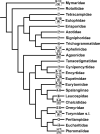Chromosomes of parasitic wasps of the superfamily Chalcidoidea (Hymenoptera): An overview
- PMID: 36761105
- PMCID: PMC9849058
- DOI: 10.3897/CompCytogen.v14i3.56535
Chromosomes of parasitic wasps of the superfamily Chalcidoidea (Hymenoptera): An overview
Abstract
An overview of the current knowledge of chromosome sets of the parasitoid superfamily Chalcidoidea is given. Karyotypes of approximately 240 members of this group, i.e. just above one percent of described species, are studied up to now. Techniques for obtaining and analyzing preparations of chalcid chromosomes are outlined, including the so-called "traditional" and "modern" methods of differential staining as well as fluorescence in situ hybridization (FISH). Among the Chalcidoidea, the haploid chromosome number can vary from n = 3 to n = 11, with a clear mode at n = 6 and a second local maximum at n = 10. In this group, most chromosomes are either metacentric or submetacentric, but acrocentrics and/or subtelocentrics also can predominate, especially within karyotypes of certain Chalcidoidea with higher chromosome numbers. The following main types of chromosomal mutations are characteristic of chalcid karyotypes: inversions, fusions, translocations, polyploidy, aneuploidy and B chromosome variation. Although karyotype evolution of this superfamily was mainly studied using phylogenetic reconstructions based on morphological and/or molecular characters, chromosomal synapomorphies of certain groups were also revealed. Taxonomic implications of karyotypic features of the Chalcidoidea are apparently the most important at the species level, especially among cryptic taxa.
Keywords: FISH; base-specific fluorochromes; chalcid wasps; differential staining; karyotypes; phylogeny; taxonomy.
Vladimir E. Gokhman.
Figures



References
-
- Altinordu F, Peruzzi L, Yu Y, He X. (2016) A tool for the analysis of chromosomes: KaryoType. Taxon 65(3): 586–592. 10.12705/653.9 - DOI
-
- Baldanza F, Gaudio L, Viggiani G. (1999) Cytotaxonomic studies of Encarsia Förster (Hymenoptera: Aphelinidae). Bulletin of Entomological Research 89: 209–215. 10.1017/S0007485399000322 - DOI
-
- Baldanza F, Giorgini M. (2001) Karyotype and NOR localization differences between Encarsiaformosa Gahan and Encarsialuteola Howard (Hymenoptera: Aphelinidae). Bollettino del Laboratorio di Entomologia agraria ‘Filippo Silvestri’ 56: 33–41.
-
- Baur H, Kranz-Baltensperger Y, Cruaud A, Rasplus J-Y, Timokhov AV, Gokhman VE. (2014) Morphometric analysis and taxonomic revision of Anisopteromalus Ruschka (Hymenoptera: Chalcidoidea: Pteromalidae) – an integrative approach. Systematic Entomology 39: 691–709. 10.1111/syen.12081 - DOI - PMC - PubMed
-
- Bolsheva NL, Gokhman VE, Muravenko OV, Gumovsky AV, Zelenin AV. (2012) Comparative cytogenetic study on two species of the genus Entedon Dalman, 1820 (Hymenoptera: Eulophidae) using DNA-binding fluorochromes and molecular and immunofluorescent markers. Comparative Cytogenetics 6(1): 79–92. 10.3897/compcytogen.v6i1.2349 - DOI - PMC - PubMed
Publication types
LinkOut - more resources
Full Text Sources
